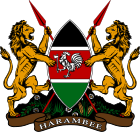 |
|---|
|
|
Local authorities in Kenya are the bodies controlling local governance in urban areas in Kenya.
From the 2013 general elections onwards Kenya will have three classes of local authorities: City, Municipality, and Town authorities. Subject to the Urban Areas and Cities Act of 2011, there are four authorities with city status: Nairobi, the national capital, Mombasa, Kisumu and Nakuru. Municipalities and towns are other forms of urban authorities and are generally named after their central town.
Local authorities usually differ from divisional and constituency boundaries used by the state administration.
Under the former act of parliament local authority administration consisted of a mayor, town clerk and councillors. The number of councillors depended on population and area of each authority and they were elected by the public during the Kenya general elections held every five years or by-elections held in between. Authorities were divided into wards and each ward elects only one councillor. Wards have often common boundaries with administrative locations.
Compared to many other countries, local authorities in Kenya were weak and are shadowed by state run administration.[1] However, during the international Africities summit held in Nairobi September 2006, the Kenyan president Mwai Kibaki promised to strengthen local authorities.[2]
Under Kenya's new devolved system of government, the elected councils were dissolved and are set to be replaced by boards, in the case of city councils, and administrators, in the case of municipal and town councils, appointed by the county governments.[3][4]
- ^ Samuel O. Owuor, B. Charlery, M. Chretin and B. Schaffner: Urban planning and management in small and medium-size towns In: Les Cahiers d’Afrique de l’Est – Supplementary Issue, 23–48, September 2006
- ^ Africities summit 2006 Archived 14 July 2007 at the Wayback Machine
- ^ End of era for 175 local authorities, http://www.nation.co.ke/News/Councils-dissolved-to-pave-way-for-counties/-/1056/1666572/-/yxrawg/-/index.html
- ^ THE URBAN AREAS AND CITIES ACT, http://siteresources.worldbank.org/INTAFRICA/Resources/257994-1335471959878/Urban_Areas_and_Cities_Act_2011.pdf